Ganesha Statues
 QuickviewCompareFavoriteGanesh Sandstone Large Garden Sculpture with Crown and Right Curved Trunk Cambodian 58"$7999
QuickviewCompareFavoriteGanesh Sandstone Large Garden Sculpture with Crown and Right Curved Trunk Cambodian 58"$7999 QuickviewCompareFavoriteGanesh Face Wall Hanging Cambodian Wood Sculpture Natural or Gold Painted Finish 17"$199
QuickviewCompareFavoriteGanesh Face Wall Hanging Cambodian Wood Sculpture Natural or Gold Painted Finish 17"$199 QuickviewCompareFavoriteBrass Hindu God Ganesh Idol Reclining on Tiger Paw Throne on a Pillow with Braid of Long Hair 8"$159
QuickviewCompareFavoriteBrass Hindu God Ganesh Idol Reclining on Tiger Paw Throne on a Pillow with Braid of Long Hair 8"$159 QuickviewCompareFavoriteGanesh Brass Statue in Abhaya Mudra with Stone Inlay, Ball of Sweets & Mooshika, India 14.5"$739
QuickviewCompareFavoriteGanesh Brass Statue in Abhaya Mudra with Stone Inlay, Ball of Sweets & Mooshika, India 14.5"$739 QuickviewCompareFavoriteShiva Parivar Brass Statue Hindu Family with Parvati, Ganesha, Murugan & Nandi 10"$219
QuickviewCompareFavoriteShiva Parivar Brass Statue Hindu Family with Parvati, Ganesha, Murugan & Nandi 10"$219 QuickviewCompareFavoriteGanesh Brass Statue in Abhaya Mudra with Ball of Sweets, Noose, Goad, and Mooshika 15"$569
QuickviewCompareFavoriteGanesh Brass Statue in Abhaya Mudra with Ball of Sweets, Noose, Goad, and Mooshika 15"$569 QuickviewCompareFavoriteGanesh Statue "The Remover of Obstacles" Small Brass Murti Abhaya Mudra of Protection 4.5"$39
QuickviewCompareFavoriteGanesh Statue "The Remover of Obstacles" Small Brass Murti Abhaya Mudra of Protection 4.5"$39 QuickviewCompareFavoriteGanesh Brass Statue Seated with Peacock Feather and Sacred Scroll Abstract God 23"$699
QuickviewCompareFavoriteGanesh Brass Statue Seated with Peacock Feather and Sacred Scroll Abstract God 23"$699 QuickviewCompareFavoriteGanesh Brass Statue Seated in Abhaya Mudra with Ball of Sweets and Mooshika 14"$399
QuickviewCompareFavoriteGanesh Brass Statue Seated in Abhaya Mudra with Ball of Sweets and Mooshika 14"$399 QuickviewCompareFavoriteBrass Ganesh Statue in Abhaya Mudra with Trident Tilak & Colored Stones 20"$1399
QuickviewCompareFavoriteBrass Ganesh Statue in Abhaya Mudra with Trident Tilak & Colored Stones 20"$1399 QuickviewCompareFavoriteBrass Large Statue of Mooshika, Ganesha's Vehicle or Vahana Holding Offering of Laddu 15"$479
QuickviewCompareFavoriteBrass Large Statue of Mooshika, Ganesha's Vehicle or Vahana Holding Offering of Laddu 15"$479 QuickviewCompareFavoriteGanesh Statue Dancing on Kalinga, the Five-Headed Serpent Hindu God Made in India 12"$99
QuickviewCompareFavoriteGanesh Statue Dancing on Kalinga, the Five-Headed Serpent Hindu God Made in India 12"$99 QuickviewCompareFavoriteGanesha Abstract Grey Granite Sculpture with Corkscrew Trunk and Round Body 35"$2999
QuickviewCompareFavoriteGanesha Abstract Grey Granite Sculpture with Corkscrew Trunk and Round Body 35"$2999 QuickviewCompareFavoriteSmoky Topaz Quartz 108 Mala Necklace For Healing & Meditation Associated with Ganesh 23"$359
QuickviewCompareFavoriteSmoky Topaz Quartz 108 Mala Necklace For Healing & Meditation Associated with Ganesh 23"$359 QuickviewCompareFavoriteMoonstone Mala with 108 Beads, 7 Chakra Stones & Amethyst Associated with The Trimurti 21"$479
QuickviewCompareFavoriteMoonstone Mala with 108 Beads, 7 Chakra Stones & Amethyst Associated with The Trimurti 21"$479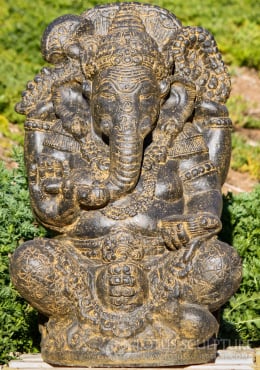 QuickviewCompareFavoriteGanesha Garden Statue Holding Elephant Goad, Malas, Vedas & Tusk Affordable Stone 32"$699
QuickviewCompareFavoriteGanesha Garden Statue Holding Elephant Goad, Malas, Vedas & Tusk Affordable Stone 32"$699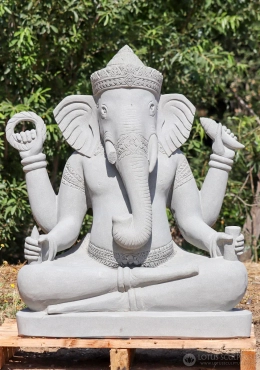 QuickviewCompareFavoriteGanesh Statue Cambodian Sandstone with Right Curved Trunk, Conch, Chakra, Tusk, and Water Vessel 40"$4999
QuickviewCompareFavoriteGanesh Statue Cambodian Sandstone with Right Curved Trunk, Conch, Chakra, Tusk, and Water Vessel 40"$4999 QuickviewCompareFavoriteGanesh Statue - Cambodian Sandstone with Conch, Chakra, Tusk, and Water Vessel 40"$4999
QuickviewCompareFavoriteGanesh Statue - Cambodian Sandstone with Conch, Chakra, Tusk, and Water Vessel 40"$4999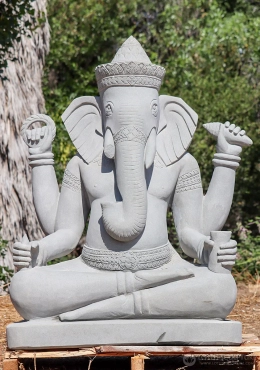 QuickviewCompareFavoriteLarge Ganesha Garden Sculpture Hand Carved from Stone in Cambodia with Right Facing Trunk 54"$7999
QuickviewCompareFavoriteLarge Ganesha Garden Sculpture Hand Carved from Stone in Cambodia with Right Facing Trunk 54"$7999 QuickviewCompareFavoriteLarge Ganesha Garden Sculpture Hand Carved from Stone in Cambodia with Left Facing Trunk 55"$7999
QuickviewCompareFavoriteLarge Ganesha Garden Sculpture Hand Carved from Stone in Cambodia with Left Facing Trunk 55"$7999 QuickviewCompareFavoriteInexpensive Fiberglass Small Abhaya Mudra Hindu God Ganesha Statue in Abhaya Mudra 8"$29
QuickviewCompareFavoriteInexpensive Fiberglass Small Abhaya Mudra Hindu God Ganesha Statue in Abhaya Mudra 8"$29 QuickviewCompareFavorite32 Forms of Ganapathi, Hindu God Ganesha Bronze Set of Lost Wax Method Statues 8.5"$17499
QuickviewCompareFavorite32 Forms of Ganapathi, Hindu God Ganesha Bronze Set of Lost Wax Method Statues 8.5"$17499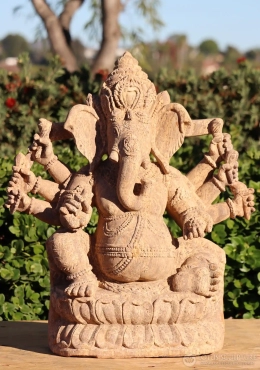 QuickviewCompareFavoriteGanesh Sandstone Statue with Eight Arms Holding Sacred Items, Left Curved Trunk 31"$1999
QuickviewCompareFavoriteGanesh Sandstone Statue with Eight Arms Holding Sacred Items, Left Curved Trunk 31"$1999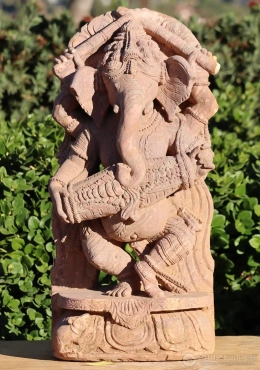 QuickviewCompareFavoriteGanesh Sandstone Sculpture Dancing with Drum and Sticks, Odisha, India 30"$1699
QuickviewCompareFavoriteGanesh Sandstone Sculpture Dancing with Drum and Sticks, Odisha, India 30"$1699 QuickviewCompareFavoriteGanesh Garden Statue Odishan Sandstone with Cobra Belt and Right-Curled Trunk 30.5"$1899
QuickviewCompareFavoriteGanesh Garden Statue Odishan Sandstone with Cobra Belt and Right-Curled Trunk 30.5"$1899 QuickviewCompareFavoriteBrass Dancing Sculpture of the Hindu God Ganesha with Lakshmi Seated on His Lap 10"$129
QuickviewCompareFavoriteBrass Dancing Sculpture of the Hindu God Ganesha with Lakshmi Seated on His Lap 10"$129 QuickviewCompareFavoriteSeated Ganesha Statue, Cambodian Bronze, Antique Green, Triple-Tiered Throne 23.5"$1199
QuickviewCompareFavoriteSeated Ganesha Statue, Cambodian Bronze, Antique Green, Triple-Tiered Throne 23.5"$1199 QuickviewCompareFavoriteGanesh Brass Statue Standing on Base Holding Noose, Trident, Mace, and Sweet, Java 15"$349
QuickviewCompareFavoriteGanesh Brass Statue Standing on Base Holding Noose, Trident, Mace, and Sweet, Java 15"$349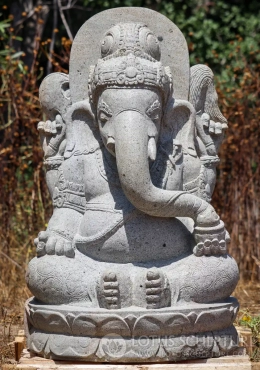 QuickviewCompareFavoriteGanesh Stone Outdoor Garden Statue Seated with Feet Together & Mahakala on Halo 34"$2899
QuickviewCompareFavoriteGanesh Stone Outdoor Garden Statue Seated with Feet Together & Mahakala on Halo 34"$2899 QuickviewCompareFavoriteBaby Ganesha Sculpture with Bowl of Sweets Hand Carved Odishan Sandstone 19"$699
QuickviewCompareFavoriteBaby Ganesha Sculpture with Bowl of Sweets Hand Carved Odishan Sandstone 19"$699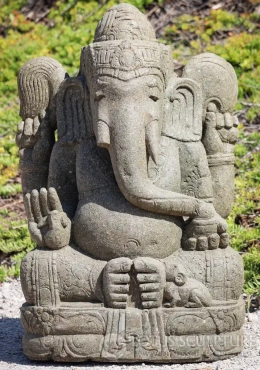 QuickviewCompareFavoriteGanesha Hindu God Stone Garden Statue in Abhaya Mudra with Mooshika, Indonesia 32"$999
QuickviewCompareFavoriteGanesha Hindu God Stone Garden Statue in Abhaya Mudra with Mooshika, Indonesia 32"$999 QuickviewCompareFavoriteElegant Brass Ganesha Deepam Lamp with 3 Tiers of Lotus Flowers & 4 Peacocks 21"$399
QuickviewCompareFavoriteElegant Brass Ganesha Deepam Lamp with 3 Tiers of Lotus Flowers & 4 Peacocks 21"$399 QuickviewCompareFavoriteLarge Brass Dancing Ganapati Statue Holding Lakshmi on His Lap with His Vehicle, the Rat 29"$1399
QuickviewCompareFavoriteLarge Brass Dancing Ganapati Statue Holding Lakshmi on His Lap with His Vehicle, the Rat 29"$1399 QuickviewCompareFavoriteReclining Ganesh Outdoor Garden Stone Sculpture Saffron Colored Reclining Hindu God 42"$2699
QuickviewCompareFavoriteReclining Ganesh Outdoor Garden Stone Sculpture Saffron Colored Reclining Hindu God 42"$2699 QuickviewCompareFavoriteGanesh Statue in Abhaya Mudra of Protection with Mooshika Brass Ganapathi Murti 13"$459
QuickviewCompareFavoriteGanesh Statue in Abhaya Mudra of Protection with Mooshika Brass Ganapathi Murti 13"$459 QuickviewCompareFavoriteLarge Ganesha Brass Statue with 6 Arms Abhaya Mudra with Colored Stones & Rat Mooshika 45"$3999
QuickviewCompareFavoriteLarge Ganesha Brass Statue with 6 Arms Abhaya Mudra with Colored Stones & Rat Mooshika 45"$3999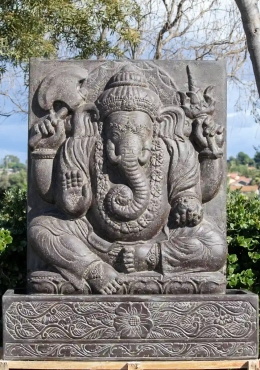 QuickviewCompareFavoriteGanesha Fountain Large Water Feature Perfect Outdoors To Bring Peace to Any Garden 53"$1499
QuickviewCompareFavoriteGanesha Fountain Large Water Feature Perfect Outdoors To Bring Peace to Any Garden 53"$1499 QuickviewCompareFavoriteGanesh Statue - Seated on Lotus Base with Goad, Noose, and Sweets - Odishan Granite 39"$3299
QuickviewCompareFavoriteGanesh Statue - Seated on Lotus Base with Goad, Noose, and Sweets - Odishan Granite 39"$3299 QuickviewCompareFavoriteGanesh Garden Sculpture Standing with Four Arms and Mooshika Odishan Granite 27"$1399
QuickviewCompareFavoriteGanesh Garden Sculpture Standing with Four Arms and Mooshika Odishan Granite 27"$1399 QuickviewCompareFavoriteGanesha Abstract Sculpture in Red-Black Marbled Granite with Left-Curving Trunk 40"$3299
QuickviewCompareFavoriteGanesha Abstract Sculpture in Red-Black Marbled Granite with Left-Curving Trunk 40"$3299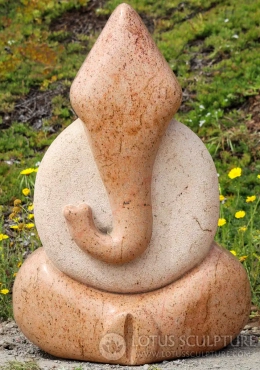 QuickviewCompareFavoriteGanesha Abstract Sculpture in Orange Granite with Right-Curved Trunk and Round Body 36"$2999
QuickviewCompareFavoriteGanesha Abstract Sculpture in Orange Granite with Right-Curved Trunk and Round Body 36"$2999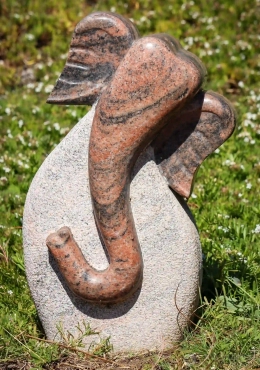 QuickviewCompareFavoriteGanesh Pink & Red Granite Sculpture, Right-Curved Trunk Abstract Form 24"$1299
QuickviewCompareFavoriteGanesh Pink & Red Granite Sculpture, Right-Curved Trunk Abstract Form 24"$1299 QuickviewCompareFavoriteMooshika Statue Brass Vahana of Lord Ganesha, the Rat Holding Deepam or Lamp in Hands 5"$49
QuickviewCompareFavoriteMooshika Statue Brass Vahana of Lord Ganesha, the Rat Holding Deepam or Lamp in Hands 5"$49 QuickviewCompareFavoriteGanesh Large Black Granite Sculpture Standing with Cobra Belt, Mooshika & Right-Curved Trunk 54"$6999
QuickviewCompareFavoriteGanesh Large Black Granite Sculpture Standing with Cobra Belt, Mooshika & Right-Curved Trunk 54"$6999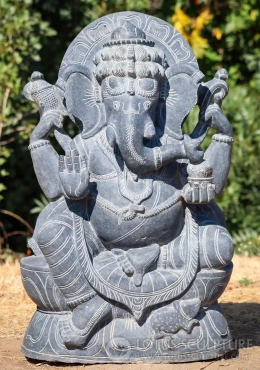 QuickviewCompareFavoriteGanesh Black Granite Garden Sculpture in Abhaya Mudra with Mooshika, Seated in Lalitasana 36"$2999
QuickviewCompareFavoriteGanesh Black Granite Garden Sculpture in Abhaya Mudra with Mooshika, Seated in Lalitasana 36"$2999 QuickviewCompareFavoriteGanesh Statue in Abhaya Mudra - Detailed Garden Sculpture with Intricate Designs 36.5"$2999
QuickviewCompareFavoriteGanesh Statue in Abhaya Mudra - Detailed Garden Sculpture with Intricate Designs 36.5"$2999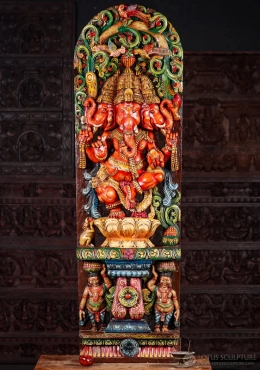 QuickviewCompareFavoriteGanesha Statue Three-Headed Dancing on Lotus, Mango, Noose & Goad, Wood 60"$1499
QuickviewCompareFavoriteGanesha Statue Three-Headed Dancing on Lotus, Mango, Noose & Goad, Wood 60"$1499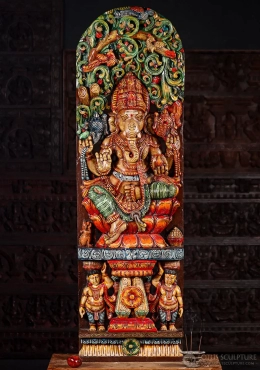 QuickviewCompareFavoriteGanesha Wood Statue South Indian Panel Vibrantly Painted with Canopy and Two Ganas 60"$1499
QuickviewCompareFavoriteGanesha Wood Statue South Indian Panel Vibrantly Painted with Canopy and Two Ganas 60"$1499HINDU GOD GANESH STATUES
About Lord Ganesha
Lord Ganesha, the Hindu god of wisdom and remover of obstacles, is revered as a symbol of the arts, sciences, and intellect. Often called upon at the start of any new endeavor, he is known to bless his devotees with success. Ganesha is also famous for his role as the divine scribe, having penned the epic Mahabharata with his broken tusk.
Ganesha's Family
Ganesha is part of a prominent divine family in Hinduism. He is the son of Lord Shiva, known as the destroyer within the Hindu trinity, and the mother goddess Parvati, who symbolizes nurture and power. His elder brother, Kartikeya (also called Skanda or Murugan), is a warrior god renowned for valor and leadership.
Why Keep a Ganesha Idol in Your Home?
Placing a statue of Lord Ganesha in your home is a time-honored tradition, inviting wisdom, protection, prosperity, and good fortune while helping remove obstacles from your life. It's often recommended to:
- Position a Ganesha idol near the main entrance to guard against negativity and foster a welcoming atmosphere.
- Keep a small Ganesha sculpture in your workspace or study room to boost focus and success in intellectual or creative pursuits.
Ganesha's presence serves as a reminder of balance, patience, and the power of new beginnings.
Types of Materials Used for Handcrafted Ganesha Statues
At Lotus Sculpture, you can buy Ganpati statues online. Our Ganesha sculptures are crafted using a variety of materials, each offering a unique aesthetic and spiritual quality:
- Brass Statues: Brass Ganpati statues are available from many regions including India, Bali, & Thailand, and are also known for their durability and very intricate design. Indian ganpati brass statues, especially, are sand cast, and comparatively cheaper.
- Bronze Statues: One-of-a-kind masterpieces, the South Indian bronze Ganesha idols are made using the lost wax method. Chinese bronze is also available as a unique alternative in its own artistic tradition.
- Marble Statues: Marble Ganesha statues are regarded as marvelously carved and elegant statues that can go well both indoors and outdoors.
- Wood Statues: Wooden Ganesha statues, hand carved, give a rustic and earthy feeling and symbolize warmth and tradition.
- Stone Statues: Ganesha sculptures made from lava stone and granite are strong and preferable for outdoor areas that want a rich antique touch.
- Fiber & Resin Statues: Fiber and resin Ganesh idols are lightweight and durable, making them ideal to use as a contemporary decor style.
Significance of Lord Ganesha's Posture
Different poses for Lord Ganesha statues signify different aspects of His divine character. Seated Ganesha Idol represents calmness and focus, which is therefore good for meditation and wisdom. Joy and energy exuded by the dancing God Ganesha become an inspiration for creativity, and positivity among the lovers of the Mahaganapati. A standing God Ganesha Statue represents readiness to remove obstacles while a reclining one offers relaxation and prosperity. The many-armed statue of him carries different symbols, such as Modak (the sweet), Lotus and noose, signifying his hubris of abundance, purity, and admonition. Arts patron Lord Ganesha Sculptures who play musical instruments such as the Veena, Tabla or flute, are shown, symbolizing the delights the god infuses in life. By feeding their intentions and witnessing Ganesha, devotees can enter into close relationships with Ganesha that speak to them personally.
God Ganesha Position in Home: Where to Place it.
It is advised to place the Ganesha murti in the most possible right-most location within your home, to amplify his protection, wisdom, and prosperity. It is traditional to position a large Ganesh statue near the house entrance, facing out, in order to keep negative energies away and invite good energies. His positivity helps people live in harmony and positivity in the living space or in the center space. If you have study areas or workspaces, a Ganesha Statue can help you to focus and remove mental blocks. Don't put him directly on the floor or next to the bathrooms, keep the environs around the statue clean and peaceful at all times to pay respects to his divine order.
Ganesha Statues You Should Include in Your Outdoor Garden
Ganesha statues add beautiful symbolic elements as you put them in your garden to create a peaceful and holy space. For the large Ganesha garden statue, for outdoor settings, lava stone, granite and marble are the best fit. Ganesha can be represented by good-quality statues of brass or bronze for two reasons. First, such statues don't rust, and second, they can resist the weather elements and enhance their elegance. In addition, we also have a large selection of abstract modern big Ganesha statues hand carved out of exotic materials that look great in the outdoor garden space.
Popular Names of Ganesha
There are many names of Ganesha as each name characterizes his divine attributes and roles. Among his popular names are Vinayaka, remover of obstacles; Ganapati, lord of all beings; Ekadanta, one having one tusk; and Vighnaharta, destroyer of obstacles. He is also called Lambodara, for his big belly representing abundance, and Gajanana from his elephant face. The names of these are still invoked in prayers and chants with the purpose of blessing them with wisdom and prosperity and success.
Whether you're looking for a centerpiece for your home, outdoor garden, or an Idol for a spiritual place, our Hindu God Ganesha statue collection offers a wide variety of designs that honor the artistry and devotion of traditional craftsmanship. Explore our range and bring the blessings of Lord Ganesha into your space.

